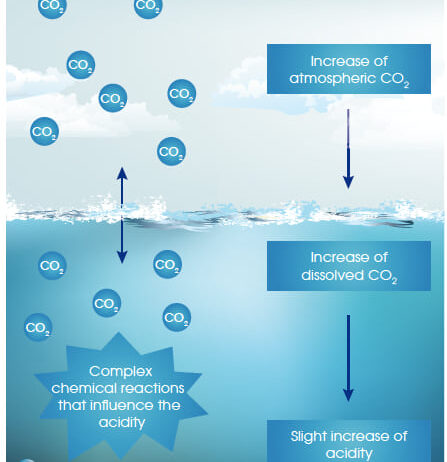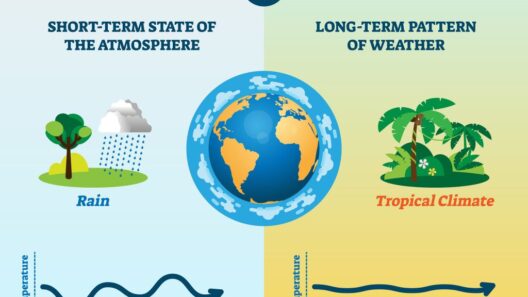The ocean, a vast expanse of blue, serves as both a mirror reflecting the sky above and a formidable force shaping the climate of our planet. Its depths conceal profound mysteries while its surface dances with the energy of the atmosphere. Often perceived merely as a backdrop to our lives, the sea wields silent yet formidable power over the Earth’s climate, acting as a critical regulator of weather patterns, temperature, and carbon cycling. Understanding the ocean’s multifaceted role in climate dynamics is essential for grasping the intricacies of our environmental challenges.
1. The Ocean as a Climate Regulator
At first glance, the ocean may appear placid, but it teems with activity beneath its surface. The ocean covers approximately 71% of the Earth’s surface and plays a pivotal role in absorbing solar radiation. This water body acts as an enormous heat reservoir, capturing about 90% of the excess heat generated by greenhouse gas emissions. By moderating temperature fluctuations, the ocean mitigates the severity of global warming, providing a buffer that prevents abrupt changes in climate.
Moreover, the ocean’s currents function as a conveyor belt for heat distribution. The great oceanic currents, such as the Gulf Stream, transport warm water from the tropics to the poles, while cold currents return the cooler water towards the equator. This intricate ballet of water movement fosters climatic stability, influencing everything from tropical cyclones to polar weather patterns. In essence, the ocean’s currents are the mythical giants shaping the elements, guiding the atmosphere’s trajectory with their powerful flow.
2. Oceanic Carbon Sink
The ocean serves as the planet’s largest carbon sink, absorbing roughly a quarter of the carbon dioxide (CO2) emissions produced by human activities. This natural carbonate system plays a crucial role in mitigating climate change. As CO2 enters the ocean, it reacts with seawater, forming carbonic acid, which is then partitioned into bicarbonate and carbonate ions. This chemical dance facilitates the growth of marine organisms, such as corals and shellfish, that rely on calcium carbonate to build their skeletal structures.
However, this beneficial interplay comes with a price. The overwhelming influx of atmospheric CO2 leads to ocean acidification, a phenomenon described as “the other CO2 problem.” As the pH of ocean water drops, the ability of marine organisms to maintain their calcium carbonate structures diminishes, threatening biodiversity and marine ecosystems. Thus, what was once a protective mechanism now poses a precarious dilemma, highlighting the delicate balance that sustains life within the ocean’s embrace.
3. Effects on Weather Patterns
The ocean exerts a significant influence on regional and global weather patterns. The phenomenon known as El Niño showcases the complex interrelations between oceanic conditions and atmospheric behavior. During an El Niño event, warmer-than-average sea surface temperatures in the Pacific Ocean disrupt normal weather patterns, leading to a cascade of climatic anomalies. The repercussions are felt globally: altered rainfall patterns, disrupted fisheries, and exacerbated extremes such as droughts and floods.
Conversely, the La Niña phase, characterized by cooler sea surface temperatures, contributes to different climatic impacts, often leading to wetter conditions in some regions and drier conditions in others. The interplay of these oscillating phases illustrates how the ocean acts as a formidable influencer of global climate, akin to a master conductor orchestrating a symphonic masterpiece, where each note reverberates far beyond its origin.
4. Role in Marine Ecosystems
The ocean is not merely a passive player in the climate system; it serves as a vibrant habitat for myriad marine species that underpin the ecological balance of Earth. These ecosystems, ranging from coral reefs to mangroves, are critical for carbon sequestration, acting as vital nurseries for juvenile fish and other marine life. Furthermore, the health of these ecosystems directly correlates with the resilience of coastal communities and their ability to adapt to climatic changes.
Yet, the specter of climate change looms over these ecosystems, threatening their integrity. Rising sea temperatures lead to coral bleaching, decimating reefs and the rich biodiversity they support. Ocean stratification resulting from warming hinders nutrient upwelling, jeopardizing fisheries that millions of people depend on for sustenance. Consequently, the fate of marine ecosystems and the communities that rely on them is intertwined, creating an urgent call to action for conservation and sustainable practices.
5. Potential Solutions and Future Directions
Addressing the ocean’s role in climate change requires a multifaceted approach that encompasses mitigation, adaptation, and restoration strategies. First, reducing reliance on fossil fuels is paramount to curtailing CO2 emissions and lessening the burden on the ocean’s carbon-absorbing capacity. Transitioning to a circular economy and investing in renewable energy sources can significantly mitigate climate impacts.
Second, protecting and restoring marine ecosystems is crucial for maintaining their resilience. Initiatives aimed at conserving mangroves, seagrasses, and coral reefs can enhance their potential to sequester carbon while supporting biodiversity. Marine protected areas (MPAs) can serve as sanctuaries for species recovery while fostering adaptive capacities in the face of climate change.
Finally, fostering international cooperation and research is essential for understanding the ocean’s responses to climate dynamics. By engaging in multidisciplinary studies, we can unravel the intricate tapestry of oceanic processes and develop informed policies that prioritize both climate action and ocean health.
The ocean, with its silent power, influences our climate in profound ways. Acknowledging this relationship and respecting the ocean’s stewardship of our planet is imperative for future generations. As the waves crash against the shore, they whisper the urgent truth: safeguarding our oceans is synonymous with safeguarding our climate and, ultimately, our very existence.







